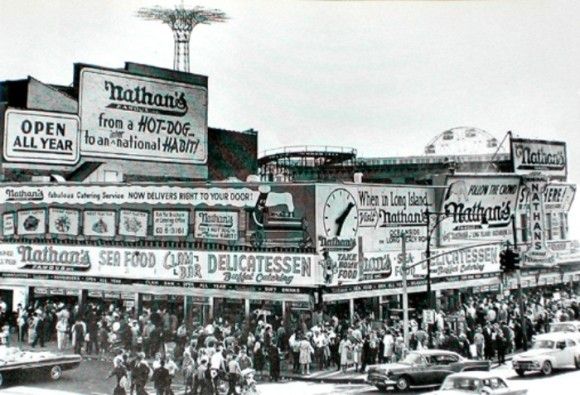History Of Nathan’s Famous Explored By Brownstoner

Every time I am tasked with writing something about the original Nathan’s Famous (1310 Surf Avenue) I get really hungry. There is something about those delicious, ketchup-covered* hot dogs, the salty crinkle-cut french fries and the sea breeze off the boardwalk at Coney Island that just presses all my happy buttons. We all know that Nathan’s is a Brooklyn institution, but a reminder never hurts. A report in Brownstoner delves into the near century-long tradition of the world’s best hot-dog palace.
Like many Coney Island businesses, Nathan’s was wrecked by Superstorm Sandy. The hot-dog headquarters had a triumphant reopening this past May after undergoing a full remodeling. After all, no mere storm was going to sink this royal house of franks. Brownstoner noted that the reopening of Nathan’s brought back something old to the new start:
It re-opened in the spring of 2013, in time for the Memorial Day weekend, the unofficial start of summer. This time, they added something new – well, something old made a comeback, rather. The new Nathan’s has a curbside clam bar again, not seen since the 1950s. It’s a revival of the restaurant’s raw bar, with East Coast oysters and littleneck clams that are shucked on order over a mountain of ice. They are served with chowder crackers, lemon wedges, horseradish and cocktail sauce.
Brownstoner rolls back the clock even further, describing how Nathan’s was born from the original hot dog inventors:
The story is a familiar rags to riches, immigrant success story. Nathan’s Famous began in the mind of an enterprising Polish immigrant named Nathan Handwerker. Prior to 1916, he was working at the famous Feltman’s German Gardens, an immensely popular restaurant on Coney Island. Charles Feltman was another success story, a German immigrant who came to the US in 1856 at the age of fifteen. His Coney Island career started with a food pushcart on the beach, but by the early 1900’s, that push cart had grown into an empire that took up an entire city block. Feltman’s entertainment and restaurant complex contained nine restaurants, a beer garden, two enormous bars, a carousel, a roller coaster, an outdoor movie theater, a hotel, a ballroom, a bathhouse, a pavilion, a maple garden and a Tyrolean village. He was now a millionaire many times over.
Today, few people remember the enormity of his business, but they do remember that here in New York, he is credited for the invention of the hot dog. (There are other contenders.) He would later comment that his decision to put a sausage on a roll was not an attempt to invent something new, but was just an expedient way of serving the meat, one that didn’t need expensive silverware, or even a plate. He sold his frankfurters for ten cents, and they quickly became the most popular item on his menu.
The report then describes how Nathan Handwerker, (a great name for a hot dog pioneer, I might add) went on to build his own empire using cheaper prices and orchestrating the myth that his hot dogs were healthier than the competition’s:
Nathan Handwerker, as a worker at Feltman’s, was of course familiar with its famous fare. It was his job to split the rolls, and deliver the franks to the grilling station. Legend has it that he slept on the floor of the restaurant in order to save money for his own business. He wanted to make a better hot dog, and he had just the person to help him – his wife Ida Greenwald Handwerker. She had a recipe enhanced with secret spice ingredients handed down from her grandmother in the Old Country. With the encouragement of fellow Feltman’s employees, pianist Jimmy Durante and singing waiter Eddie Cantor, Nathan and Ida pooled together their savings, and with that $300, went into the hot dog business. In order to make their mark, and drum up their initial business, Nathan’s charged only five cents for their hot dogs, while Feltman’s were twice as much, at ten cents. It worked. The good tasting, cheaper hot dog was an enormous hit.
The dogs were sold at the small Nathan’s Famous stand on the corner of Surf and Stillwell Avenues, beginning in 1916. Nathan was a great idea man, and like all of the great Coney Island entrepreneurs, had more than a bit of the showman in him. He knew that a food like the hot dog would be suspicious to many people, especially in those early days before food inspectors. Ground meat products in casings, like hot dogs and sausages, caused many a raised eyebrow as to their content. They didn’t call it “mystery meat” for nothing. So he devised a two-fold strategy to overcome that stigma.
First, he had all of his servers dress in clean white surgeon’s smocks, to show cleanliness. He then handed out flyers to the local hospitals telling staff that they could eat for free, if they came to Nathan’s in their hospital white uniforms. Soon, long lines of doctors, nurses and aides, all in white, were standing in lines at the stand. Hey, if health professionals ate here in droves, it must be healthy, good food, right? Nathan’s never looked back.
Amazing stuff. The report goes on to detail the menu items added over the years and the subsequent massive expansion of the business over the years. I think I’m gonna hop on the Q-train now and grab a dog, but if your mouth isn’t quite watering yet, you can read the entire report by clicking here.
*Neditor’s note – Ketchup? F’ing ketchup?! MUSTARD! SPICY BROWN DELI MUSTARD! Ugh. I apologize to our readers for Willie’s uncivilized tastes. Freakin’ transplants.




